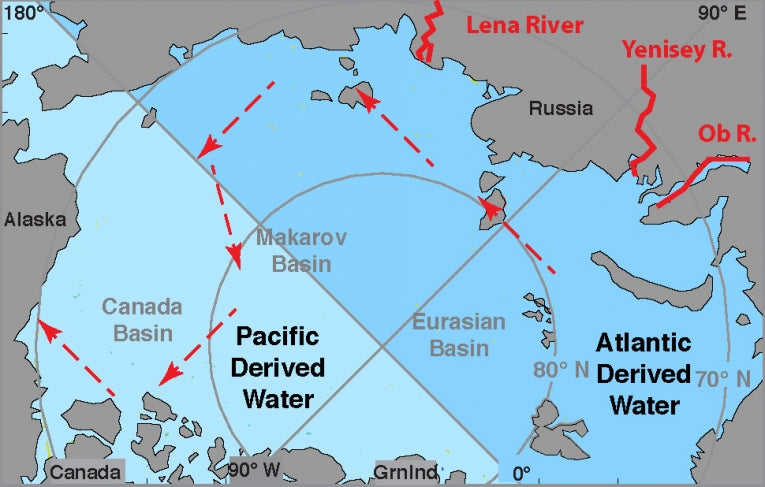Freshwater flowing into the Arctic Ocean from three Russian rivers has ended-up hundreds of miles off-course by changes in atmospheric pressure. The freshwater was drawn away from the Eurasian Basin, which lies between Greenland and Russia, to the Beaufort Sea, off the US/Canada border.
The huge diversion, which was the equivalent of adding 10feet (3metres) to the middle of the Beaufort Sea, was due to a long-term change in atmospheric pressure caused by the
Artic Oscillation, says a report in the latest issue of the journal, Nature.
Jamie Morison, lead author and oceanographer with the University of Washington's Applied Physics Laboratory, says, "Knowing the pathways of freshwater in the upper ocean is important to understanding global climate because of freshwater's role in protecting sea ice - it can help create a barrier between the ice and warmer ocean water below - and its role in global ocean circulation.
"Too much freshwater exiting the Arctic would inhibit the interplay of cold water from the poles and warm water from the tropics."

An instrument about to be dropped through an opening in the ice to the seafloor will record ocean bottom pressure to compare with similar data recorded by NASA's GRACE satellites; C. Peralta-Ferriz/UW Applied Physics Laboratory
The report's seven authors, from the University of Washington and the North American Space Agency's Jet Propulsion Laboratory, are the first people to notice the freshwater diversion and its link to the Arctic Oscillation.
The group took water samples and studied images and data of the ocean heights and ocean floor pressures from NASA satellites GRACE and ICESat.
Ron Kwok, co-author and senior research scientist with the Jet Propulsion Laboratory in Pasadena, California, says, "Changes in the volume and extent of Arctic sea ice in recent years have focused attention on the impacts of melting ice. The combined GRACE and ICESat data allow us to now examine the impacts of widespread changes in ocean circulation."
The diversion of the river water has made the Eurasian Basic more salty and the Beaufort Sea in the Canadian Basin the freshest it has been for 50 years.
Ron Kwok explains, "The freshening on the Canadian side of the Arctic over the last few years represents a redistribution of freshwater, there does not seem to be a net freshening of the ocean."
Because of the changes, less freshwater has entered the cold halocline layer, which could be a reason why ice has reduced there, says Jamie Morison. The halocline acts as a barrier between the ice and warmer water flowing from the Atlantic. If the salt is reduced, the lighter freshwater flows over the warm water.

Increasing freshwater on the U.S. and Canadian side is balanced by decreasing freshwater on the Russian side, so that on average the Arctic did not have more freshwater. Here blue represents maximum freshwater increases and the yellows and oranges represent maximum freshwater decreases; NASA JPL/University of Washington
Freshwater from various sources already flows into the Beaufort Sea, particularly if a phenomenon called the Beaufort High forces winds to spin the water in a clockwise direction. In weaker winds, or those turning anticlockwise, freshwater flows back to other parts of the Arctic Ocean.
The salinity started to fall in the 1990s, when the Beaufort High reduced, the team says, and not, as other scientists have claimed, when the Beaufort High is at its strongest. "We discovered a pathway that allows freshwater to feed the Beaufort gyre. The Beaufort High is important but so are the broader-scale effects of the Arctic Oscillation," Ron Kwok says.
Jamie Morison adds, "A number of people have come up with ways of looking at regional forces at work in the Arctic. To better understand changes in sea ice and the Arctic overall we need to look more broadly at the hemisphere-wide Arctic Oscillation, its effects on circulation of the Arctic Ocean and how global warming might enhance those effects."
The team says the Arctic Oscillation has stayed in its current state for 20 years, but, if it stops creating low pressure, the freshwater route should change back.
The satellite measurements were crucial in obtaining the findings. Jamie Morison says, "To me it's pretty spectacular that you have these satellites zipping around hundreds of kilometres above the Earth and they give us a number about salinity that's very close to what we get from lowering little sampling bottles into the ocean."
The report's other co-authors are Cecilia Peralta-Ferriz, from the University of Washington's School of Oceanography and Matt Alkire, Ignatius Rigor, Roger Andersen and Mike Steele, from the University of Washington's Applied Physics Laboratory.
The study was finance by the National Science Foundation, an independent American government agency responsible for promoting science and engineering through research programs and education, and NASA.










